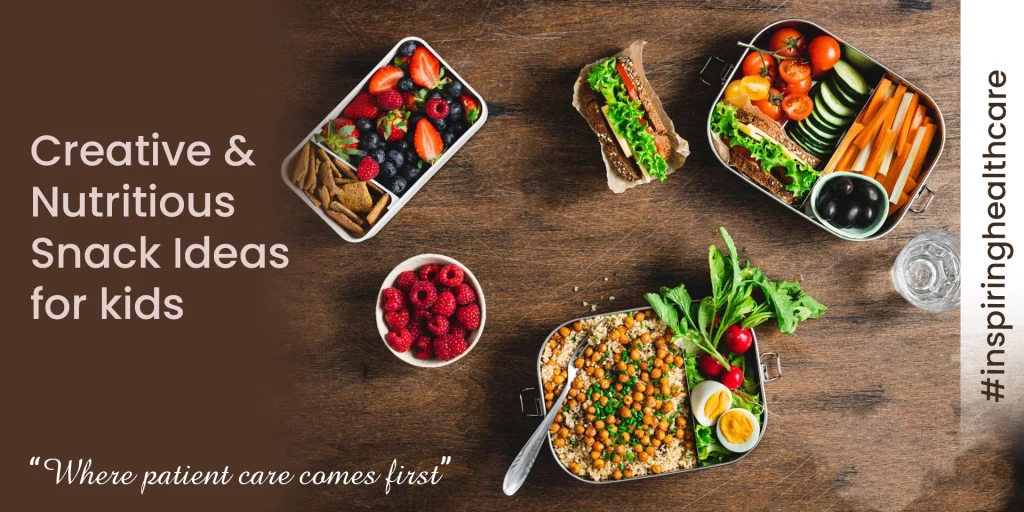As parents and caregivers, we all want the best for our kids, right? And that includes making sure they eat well. But with so many snacks out there, it can be tricky to know what’s truly good for them.
That’s where this blog comes in! We’re here to talk about healthy snacking for kids – what it means, why it’s important, and how to do it right.
Think of snacks as little boosts of energy and goodness that keep your child going throughout the day. But not all snacks are created equal! Some are packed with the stuff kids need to grow big and strong, while others are full of empty calories.
In this blog, we’ll break it all down for you. We’ll explore what makes a snack healthy, share some yummy ideas, and give tips for encouraging good snacking habits in your little ones.
So, if you’re ready to learn how to make snack time a win-win for both you and your kids, stick around! We’ve got plenty of tasty and nutritious ideas coming your way.
Also Read: Nutrition Tips for Picky Eaters: A Guide for Parents
Understanding the Nutritional Needs of Children
Key Nutrients for Children’s Growth
Children’s growth relies on a balanced diet comprising essential nutrients such as carbohydrates, protein, fats, vitamins, and minerals. These nutrients are crucial in various bodily functions, ensuring optimal development and overall well-being. Among the key nutrients for children’s growth are:
- Calcium: Essential for healthy bone development, particularly during growth spurts in adolescence. Inadequate calcium intake during this period can increase the risk of osteoporosis or weakened bones in adulthood.
- Iron: Necessary for hemoglobin production, which transports oxygen in the blood. Iron deficiency can lead to anemia, characterized by symptoms like fatigue, weakness, and poor concentration.
- Vitamin D: Important for bone health and immune function. A deficiency in vitamin D can lead to conditions like rickets, causing weak bones and skeletal deformities.
- Zinc: Supports growth, immune function, and wound healing. Zinc deficiency may result in growth retardation, delayed sexual maturation, and compromised immune response.
- Vitamin B12 is essential for forming red blood cells and nerve function. Deficiency in vitamin B12 can lead to anemia, fatigue, and nerve damage.
- Potassium: Vital for muscle and nerve function. Potassium deficiency can cause symptoms like muscle weakness, cramping, and irregular heartbeat.
- Fiber: Important for digestive health. Insufficient fiber intake can lead to issues like constipation and digestive problems.
Recommended Daily Intake for Different Age Groups
The recommended daily intake of nutrients varies based on the age of the child. Here’s an overview:
- Children aged 2-3 years: Require approximately 1,000 calories per day.
- Children aged 4-8 years: Need about 1,200-1,400 calories per day.
- Children aged 9-13 years: Should aim for 1,600-2,000 calories per day.
- Teenagers aged 14-18 years: Require around 1,800-2,400 calories per day, depending on factors such as gender and physical activity level.
Specific nutrient requirements also vary by age. For example:
- Children aged 4-8 should aim for 1,000-1,200 mg of calcium per day.
- Teenagers aged 14-18 need approximately 1,300 mg of calcium per day.
Common Deficiencies and Their Impact
Nutrient deficiencies are common in children and can have significant health implications:
- Iron Deficiency: This can lead to anemia, characterized by fatigue, weakness, and poor concentration.
- Calcium Deficiency: This may result in weak bones and increase the risk of osteoporosis in adulthood.
- Vitamin D Deficiency: Can cause rickets, a condition characterized by weak bones and skeletal deformities.
- Zinc Deficiency: May impede growth, delay sexual maturation, and compromise immune function.
- Vitamin B12 Deficiency: Can induce anemia, fatigue, and nerve damage.
- Potassium Deficiency: Manifests as muscle weakness, cramping, and irregular heartbeat.
- Fiber Deficiency: This can lead to constipation and digestive problems.
Creative Ideas for Healthy Snacking for Kids

Here are some creative and nutritious snack ideas for kids:
- Dosa Waffles: Try these savory waffles made with traditional Indian dosa batter.
- Potato Fry Toast: Enjoy crispy potato fry toast drizzled with Maggi hot and sweet chili sauce.
- Paneer Masala Wrap: Wrap up leftover paneer masala in a store-bought wheat tortilla for a quick bite.
- Bread Pizza: Top bread slices with marinara sauce, veggies, and cheese, then toast for a simple and tasty pizza alternative.
- Paniyaram: Make delicious paniyaram using leftover dosa batter, served with tangy onion chutney.
- Vegetable Soup: Warm up with a comforting vegetable soup, perfect with crunchy croutons or a side of grilled cheese.
- Masala Corn Toast: Whip up these easy and flavorful masala toasts with sweet corn, cheese, and a blend of spices.
- Nutritious Snack Ideas: Macaroni in Cheesy Carrot Sauce: Indulge in creamy macaroni infused with vibrant carrot purée, melted cheese, and a whole wheat-based white sauce.
These snack ideas offer both creativity and nutrition, ideal for kids in India. For more inspiration, explore the provided links for additional recipes and videos.
Strategies for Encouraging Healthy Snacking Habits
Encouraging Healthy Snacking for Kids can be tough, but there are ways to make it easier:
- Get them involved:
- Letting kids help pick and prepare snacks gets them excited about eating healthier. Try letting them choose from a bunch of options when planning meals or grocery shopping.
- Be a good role model:
- Kids are more likely to munch on healthy snacks if they see their grown-ups doing it too. So, snack healthy yourself!
- Create a snack-friendly space:
- Keep lots of healthy snacks around the house and limit the not-so-healthy stuff. Stock up on fruits and veggies, pack healthy snacks for school or outings, and cut back on sugary drinks and snacks.
- Teach balance:
- Show kids that it’s okay to enjoy treats in moderation. Offer a mix of healthy snacks in the right portions and keep the not-so-healthy ones in check.
Here are a few extra tips:
- Make healthy snacks fun and exciting.
- Offer a variety of options to keep things interesting.
- Avoid using food as a reward or punishment.
Healthy Snacking for Kids for Various Situations
On-the-go snacks for busy days: For quick snacks while on the move, it’s handy to prepare portable options like cheese sticks, carrot sticks, and frozen yogurt pops. Additionally, you can rely on shelf-stable snacks such as granola bars, nuts, and seeds for a convenient and satisfying munch.
Pre- and post-workout snacks for active children: Before exercising, children can benefit from a snack that offers a mix of carbohydrates and a bit of protein. Think of options like a banana with peanut butter or a yogurt smoothie. After a workout, they can refuel with snacks rich in protein and carbohydrates, aiding in recovery. Consider choices like chocolate milk, a turkey and cheese roll-up, or a fruit and yogurt parfait.
Healthy snacks for school lunches and after-school activities: When packing snacks for school or after-school fun, aim for nutritious and enticing options. Ideas like apple “cookies,” veggie nuggets, and frozen grapes are sure to please. Don’t forget about classics like whole fruits, sliced vegetables, hummus, whole grain crackers, and yogurt topped with fruit and honey.
For personalized guidance on healthy snacking and pediatric care, choose Sanjivini Super Specialty Hospital, Lucknow. We’re committed to supporting your child’s well-being every step of the way.

